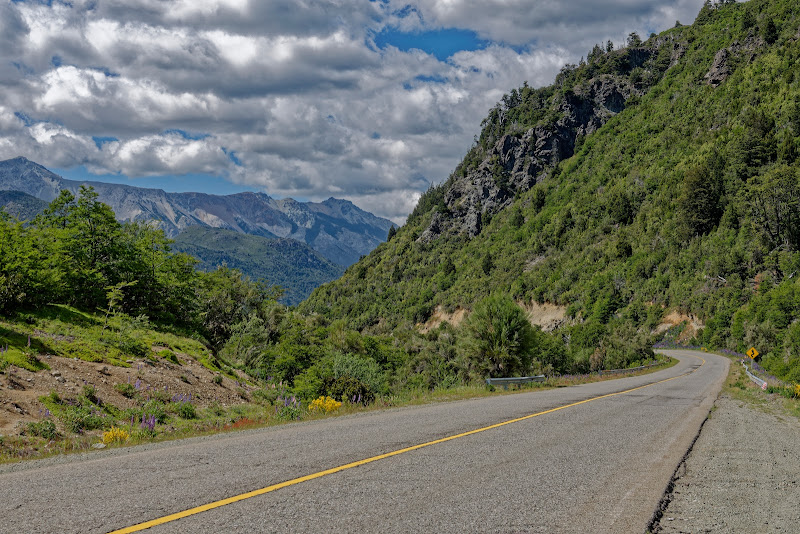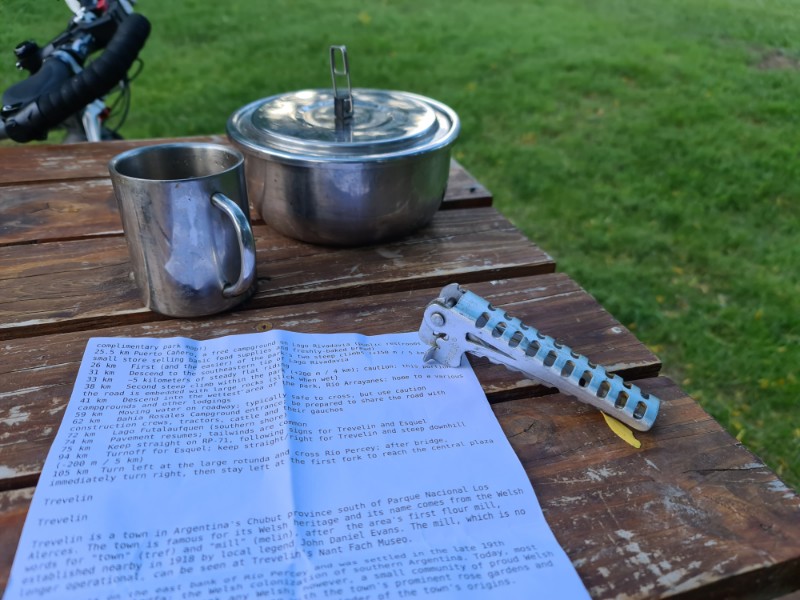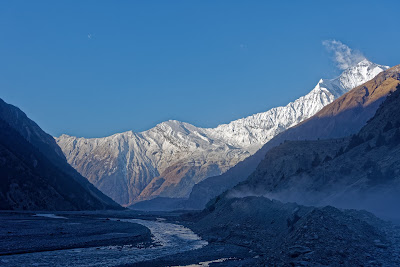El Bolsón, Butch Cassidy, Los Alerces National Park, Futaleufú and Carretera Austral
Dec. 10th 2022 - Rio Villegas
Along many lakes (Lago Gutierrez, Lago Mascardi, Lago Guillelmo) and beneath impressive mountain ranges on a very sunny day. Made an early stop after 75km, bought a beer, chips and a very spicy sauce for my pasta all in Rio Villegas. Very quiet camp site, family run, no showers, but the rapid Rio just a few meters away. Short dip in the river and a shower with my drinking bottles, all a bit cold. Drinking water on the way no problem so far, lots of creeks, sometimes I use my mechanical water filter.
Dec. 11th 2022 - El Bolson
As yesterday a short day, but this time a place full of life in the afternoon. A fare with many things I really do not need at the moment, like handcrafted figures of wood, many restaurants and a lot of people out and about. Shops seem to open at 5pm again, need some food for the next days and camping gas, that was not sold here on the artisan market.
El Bolsón
El Bolsón is a town in the southwest of Argentina, known for its mild climate due to its location near mountain valleys. It was first inhabited by Chilean farmers in 1885 and later became a popular destination for hippies from Buenos Aires in the 1970s who practiced horticulture and handcrafts. El Bolsón has a tourism economy based on outdoor activities such as fly fishing, trekking, rafting, and climbing, as well as artisanal products like cheeses, smoked trout, beer, chocolates, ice cream, jams and preserves. The first inhabitants of the Bolsón region were the Tsonek, a hunter-gatherer tribe who were strongly influenced by the Mapuche people. Later, Europeans and Argentinians arrived in the area, resulting in frequent conflicts with the Mapuche. El Bolson was founded on January 28, 1926 when locals gathered at the home of Candido Azcona and signed a charter to create the first politically administrative organization in the region. The elected members were Pedro Pascual Ponce (President), Candido Azcona (Vice President), Antonio Merino Rubio (Secretary), José Ulieldin (Treasurer), and Miguel Anden (pro-treasurer).
Dec. 12th 2022 -Cholila and PN Los Alerces
Just met with Butch Cassidy and Sundance Kid and told them I have no time for their shenanigans. I have a mission and will cycle this afternoon when I have finished my drink in the gas station to Los Alerces. But I am sad to miss the worldfamous Asado here in Cholila.
Butch Cassidy
Butch Cassidy was an American outlaw and the leader of the "Wild Bunch" gang in the Old West. He was forced to flee the country with his accomplice Harry Longabaugh ("the Sundance Kid") and Longabaugh's girlfriend Etta Place, eventually ending up in Bolivia, where it is believed they were killed in a shootout with the Bolivian Army in November 1908. The exact circumstances of their fate remain disputed. In 1901, Butch Cassidy, the Sundance Kid and Etta Place traveled to Buenos Aires, Argentina and then settled in a four-room log cabin on a 15,000-acre ranch near Cholila. In 1905, they sold the ranch and moved north towards Bariloche. The restored cabin is open to the public today.
Dec. 13th 2022 Lago Futalaufquen - southern shore
Up and down, never straight. Along many nice lakes and mountain ridges to the southern shore of Lago Futalaufquen. Huge but nice campsite and just in time to watch Argentina play Croatia. Public viewing in a restaurant here, a real blockbuster, no cars noone else outside.
Los Alerces National Park
Los Alerces National Park is located in the Andes of Argentina and has a western boundary with Chile. The park features moraines, glacial cirques, clear-water lakes, temperate forests, alpine meadows, and an alerce forest which is home to endangered species of flora and fauna. It is important for the conservation of the last portions of Patagonian Forest in an almost pristine state. Los Alerces National Park is a World Heritage Site located in Argentina, created in 1937 to protect alerce trees and other flora of the Patagonian Andes. It is known for its alerce forest, which is the largest in Argentina, as well as its tallest tree, which is 57 metres tall and 2,600 years old. The park covers an area of 7,407 hectares, including two arms of Lake Menéndez and the Amutui Quimey Reservoir, as well as their respective streams.
Dec. 14th 2022 Chile again - Futaleufu
Up to Trevellin there was a paved road.But from then on gravel and hard headwind. The combination deep gravel, climbing, dust from passing cars and strong headwind is one of my favorites. Argentinian border control was quick, but Chile checks every bag for agricultural products like tomatoes.
Trevelin
Trevelin is a town in western Chubut, Argentina. It was named after the first flour mill built there by John Daniel Evans in 1891. Evans was nicknamed 'El Baqueano' for his expeditions in search of new lands and mineral reserves. One attraction of Trevelin is Malacara's grave, the horse that saved Evans' life from an indigenous attack in 1884.
Dec. 15th 2022 Along the Fu
Futaleufu to Villa Santa Lucia. Most of it gravel, most of it up and down. Phantastic views to the lakes, the river Fu and the surrounding mountains. Small family run camp site, the spot at Lago Yelcho seems private property now.
Futaleufú
Futaleufú is a popular access point for those looking to do rafting, kayaking, treks, horseriding, mountain biking and fly-fishing, with Palena 91km south being another border crossing with Argentina. There are lush national parks, exciting routes, and good accommodation and food.
The road west of Futaleufú and Palena leads to Villa Santa Lucía on the Carretera Austral. Continuing south, La Junta is the crossroads to two spectacular detours: Lago Verde (for horseriding route to La Tapera) and Raúl Marín Balmaceda (with abundant wildlife, views of Volcán Melimoyu, and access to Parque Nacional Corcovado and hot springs).
Futaleufú was founded in 1929 by Police Chief José Felmer Patof and a group of surveyors. It had been an inhospitable, dense forest before the first settler, Don Ceferino Moraga, arrived in 1912. Moraga and his family were allegedly killed by Chilean pioneers wanting to populate the region, though no one was punished for their deaths. The town wasn't connected to the Carretera Austral until 1980 and still has strong Argentine influences today.
Villa Santa Lucía
Villa Santa Lucía is a bus stop along the Carretera Austral, named after Pinochet's wife. It serves as a junction for southbound and northbound buses, and hitchhikers often wait there for rides.
Dec. 16th 2022 - La Junta
A short ride over two "Golden Gate Bridges" along the river Frio with views to snowcapped mountains. Paved all the way by now but rolling hills with some steep ascents. Small campsite again, a family opening their small garden for the holiday season.
La Junta
La Junta is a transport hub located at the confluence of two rivers and two roads. It was a strategic hub for 19th century traders, but today it offers little to visitors. It is home to an impressive monument to Pinochet, showing the favorable sentiment towards him in the area. La Junta was founded in 1963, and opened its first school in 1970. It is situated at an important junction of the Carretera Austral, and is located between Alto Palena and Raúl Marín Balmaceda, which was originally called Bajo Palena. The Río Palena runs through all three towns.
Father Ronchi
Father Ronchi was a self-proclaimed 'rascal priest' who moved to remote Chilean Patagonia in 1960 with the goal of transforming the region. Over the course of three decades, he created new villages, built chapels, schools, lodges, boats, and workshops, and developed social enterprises. Although he had many supporters, some disagreed with his focus on the poorest communities and his methods. The following year he moved to the Shelter San Luis in Puerto Cisnes, Region XI of Chile. He worked closely with local authorities and businesses to help the locals spiritually, personally, socially and economically. In 1967 he moved back to Rancagua to become the local parish priest but returned to Puerto Cisnes five years later. He worked in the Parish of Nuestra Señora del Trabajo for over 20 years before being granted Chilean nationality for his life's work. He installed FM radio antennas and television transmitters, built chapels and lodges, and provided food aid. Father Antonio Ronchi died on 17 December 1997 in Santiago, aged 67. He was buried in Puerto Aysén and now has a foundation named after him to keep his legacy alive.













































































